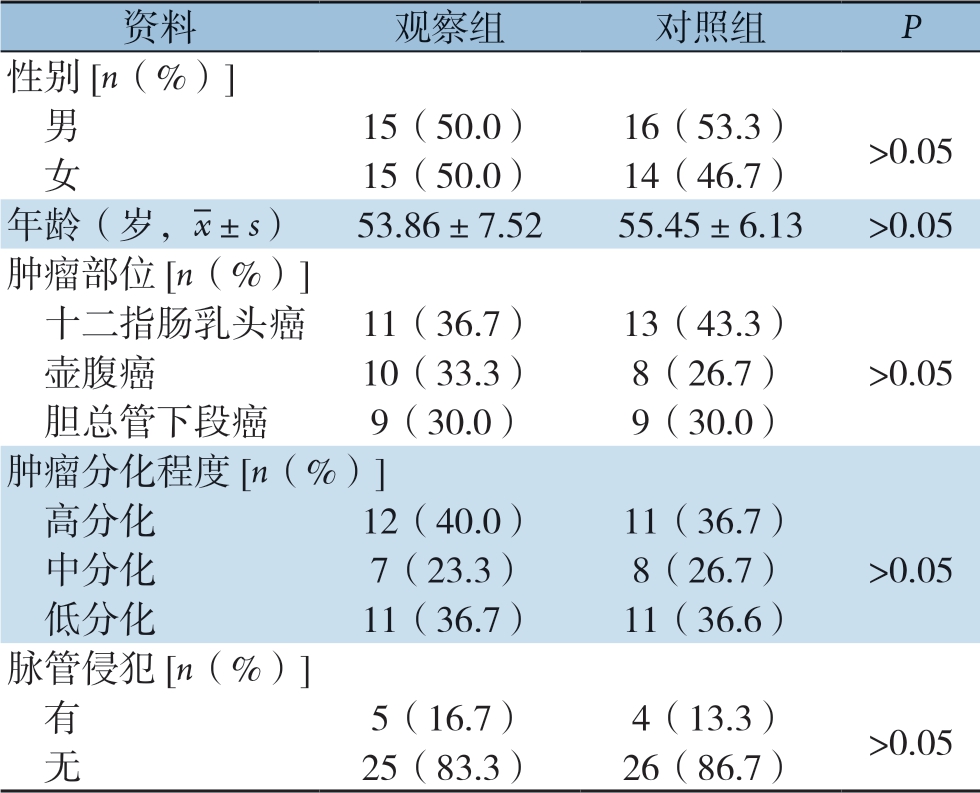壶腹区肿瘤系指来自于胰头部、Vater 壶腹、下段胆总管及十二指肠黏膜的肿瘤组织[1],虽然发病率较低,在整个胃肠道恶性肿瘤中仅仅占0.5%,但是却是恶性程度极高的肿瘤[2]。胰十二指肠切除术(PD)和保留幽门的胰十二指肠切除术(PPPD)被大多数学者认为是治疗壶腹区肿瘤的最佳方式[3]。壶腹部癌5年生存率也仅为24%~28%,即便患者接受壶腹部癌根治术后,部分患者也会因术中清扫淋巴结不彻底而出现肿瘤复发或转移,淋巴结的彻底清扫对壶腹部癌症患者的预后显得至关重要[4]。因此,术中是否能显示淋巴结并彻底清扫淋巴结是保障壶腹部癌手术效果和患者术后生存几率的重要环节之一。迄今为止,纳米炭注射液作为一种优秀的示踪剂,广泛的应用在乳腺癌、甲状腺癌、结肠癌、胃癌、胆囊癌等癌症的治疗中[5-9]。腔镜手术中通过示踪可以明确淋巴位置,用视觉辅助腔镜下的触觉的不足[5,10-11];可以明确淋巴位置,增加清扫淋巴数目,提高根治率,降低手术创伤,降低住院日[7-9, 12];在甲状腺手术中可以降低甲状旁腺误伤率,有效的保护甲状旁腺[6, 13],然而纳米炭注射于壶腹部癌患者中研究尚不多。本研究在壶腹癌患者行胰十二指肠根治术中应用纳米炭混悬液作为淋巴结示踪剂,观察纳米炭淋巴示踪指导壶腹部癌淋巴结清扫的 作用。
1 资料与方法
1.1 一般资料
选择2015年7月—2017年9月在我院进行治疗的壶腹癌患者,按随机对照表将所有患者随机分为两组:对照组30例和观察组30例。对照组男16例,女14例;年龄(55.45±6.13)岁。观察组男 15例,女15例;年龄(53.86±7.52)岁。所有入选患者均经影像学、生化或病理刷片等确诊为壶腹部癌(包括十二指肠乳头癌、壶腹癌和胆总管下段癌),未行放化疗,排除重要动脉侵犯、远处转移的晚期患者以及胰腺癌。两组患者一般资料均无统计学差异(均P>0.05)(表1)。所有患者均接受壶腹部癌根治术(胰十二指肠切除术+淋巴结清扫)。患者术前签署知情同意书,经医院伦理委员会批准。
1.2 操作方法
剖开腹腔,暴露术野,观察组取纳米炭注射液1 mL(重庆莱美药业股份有限公司,国药准字H20073246),在癌旁周缘的十二指肠降段浆膜及胰头包膜下分上、下、左、右4点注射。对照组取生理盐水1 mL,注射方法同上。等待15 min后再继续行胰十二指肠切除操作,同时观察淋巴结黑染情况。淋巴结清扫包括第1站淋巴结(N1)(第13、17组),第2站淋巴结(N2)(第6、8、12a、12p、12b、14组),以及第3站淋巴结(N3)(第7、9、15、16组)。观察组中如果根治范围外有黑染的淋巴结也一并予清扫。切除标本移除后由专人立即解剖摘取淋巴结,登记观察组与对照组观察组N1、N2、N3的部位、个数、大小、是否黑染。所有淋巴结经10%福尔马林液固定,常规石蜡包埋。
表1 两组患者一般临床资料(n=30)
Table 1 The general data of the two groups of patients (n=30)

资料 观察组 对照组 P性别[n(%)] 男 15(50.0) 16(53.3) >0.05 女 15(50.0) 14(46.7)年龄(岁, ±s) 53.86±7.52 55.45±6.13 >0.05肿瘤部位[n(%)] 十二指肠乳头癌 11(36.7) 13(43.3)>0.05 壶腹癌 10(33.3) 8(26.7) 胆总管下段癌 9(30.0) 9(30.0)肿瘤分化程度[n(%)] 高分化 12(40.0) 11(36.7)>0.05 中分化 7(23.3) 8(26.7) 低分化 11(36.7) 11(36.6)脉管侵犯[n(%)] 有 5(16.7) 4(13.3) >0.05 无 25(83.3) 26(86.7)
±s) 53.86±7.52 55.45±6.13 >0.05肿瘤部位[n(%)] 十二指肠乳头癌 11(36.7) 13(43.3)>0.05 壶腹癌 10(33.3) 8(26.7) 胆总管下段癌 9(30.0) 9(30.0)肿瘤分化程度[n(%)] 高分化 12(40.0) 11(36.7)>0.05 中分化 7(23.3) 8(26.7) 低分化 11(36.7) 11(36.6)脉管侵犯[n(%)] 有 5(16.7) 4(13.3) >0.05 无 25(83.3) 26(86.7)
1.3 评价指标
术中监测指标:手术总时间、淋巴结清扫时间、出血量和淋巴结清除数目;术后监测指标:淋巴漏发生率、术后住院时间。
1.4 统计学处理
SPSS 19.0统计软件进行分析,计量数据以均数±标准差( ±s)表示,并用t检验比较,计数资料用χ2检验,P<0.05为差异有统计学意义。
±s)表示,并用t检验比较,计数资料用χ2检验,P<0.05为差异有统计学意义。
2 结 果
2.1 两组淋巴结清扫结果比较
观察组共清扫出468枚淋巴结,平均每例患者约(15.23±7.37)枚,其中有416枚黑染,黑染率为88.9%。对照组清扫出268枚淋巴结,平均每例患者约(9.77±8.41)枚。观察组平均淋巴结清扫数目明显多于对照组,差异有统计学意义(P<0.05)。
2.2 两组淋巴结清扫情况比较
两组所清扫淋巴结清扫数目差异主要是N1站淋巴结(P=0.002),其中两组患者N 2 和N 3 站淋巴结总数未见统计学差异(均P>0.05);两组发生淋巴结转移的淋巴结数差异无统计学意义(P=0.846)(表2)。
表2 两组患者淋巴结清扫情况比较[n=30,n(%)]
Table Comparison of the lymph node dissections between the two groups of patients [n=30, n(%)]

淋巴结情况 观察组 对照组 χ2 P N1 116(24.8) 41(15.3) 9.141 0.002 N2 325(69.4) 212(79.1) 8.061 0.06 N3 27(5.8) 15(5.6) 0.009 0.923淋巴结转移数目 17(3.6) 9(3.4) 0.038 0.846
2.3 两组患者手术结果比较
观察组手术时间(237.07±37.19)min,对照组(218±40.34)min,两组间差异无统计学意义(P>0.05);对照组淋巴漏发生率为16.7%,观察组为13.3%,差异无统计学意义(P>0.05);观察组患者术中出血量(318±30)mL,对照组(592±60)mL,观察组术中出血量较对照组明显减少(P<0.001);观察组平均住院时间也短于对照组,但差异无统计学意义(P=0.153)(表3)。
表3 两组患者手术相关指标比较(n=30)
Table 3 Comparison of the surgery-associated variable between the two groups of patients (n=30)

指标 观察组 对照组 t/χ2 P 手术时间(min, ±s) 237.07±37.19 218±40.34 1.904 0.062出血量(mL,
±s) 237.07±37.19 218±40.34 1.904 0.062出血量(mL, ±s) 318±30 592±60 -22.4 <0.001淋巴漏[n(%)] 4(13.3) 5(16.7) — 1.000住院时间(d,
±s) 318±30 592±60 -22.4 <0.001淋巴漏[n(%)] 4(13.3) 5(16.7) — 1.000住院时间(d, ±s) 15±9.2 19±12 -1.45 0.153
±s) 15±9.2 19±12 -1.45 0.153
3 讨 论
现阶段壶腹部癌根治术中淋巴结清扫存在以下几个问题:⑴ 壶腹部癌位于腹膜后位,仅依靠手术医师肉眼判断和寻找淋巴结是有一定难度的,容易发生转移或微转移淋巴结残留[14];⑵ 淋巴管与周围组织难以分辨,清扫过程中容易忽略破损,导致术后淋巴漏,延长住院时间;⑶ 每个壶腹部癌患者癌细胞淋巴转移的途径、范围均有不同,仅常规清扫相同的淋巴结清扫范围,极有可能清扫范围过小导致淋巴结残留,或范围过大造成不必要的创伤和并发症[15]。如果找到可应用于壶腹部癌根治术中有效的淋巴结示踪剂,将降低淋巴结清扫的困难,提高淋巴结的清扫数目,从而改善患者预后。
Chen等[16]证实纳米炭注射液具有高度的淋巴结趋向性,很少进入人体血管,进入淋巴管后被巨噬细胞识别并吞噬,停滞在淋巴结内,使其出现可视性的黑染,这种淋巴结示踪作用对提高胃食管肿瘤淋巴结清扫数目有显著帮助,故目前将纳米炭注射液已应用于乳腺癌、胃癌、甲状腺癌和直肠癌根治术中[17-19]。Strobel等[20]报道了转移淋巴结的清扫数目与患者预后密切相关,壶腹部癌淋巴结癌灶转移是影响患者预后的一个重要因素[21],因此提高壶腹部癌根治术中的清扫彻底性就具有重要临床意义。但对于胰头癌等壶腹部肿瘤的淋巴清扫范围,学术界存在争议,因为此类肿瘤治疗效果差,且大多数研究样本量较小,很难形成统一的意见。部分学者[22]认为扩大清扫尤其是对16组淋巴结整组的清扫,并不能显著增加患者生存时间,不推荐扩大清扫,但也有学者[23]会在评估患者基本情况后尝试进行清扫,有学者[24]认为对16组淋巴杰亚组(16a2b1)的意义重大,也有学者[25]认为不对后腹膜神经组织及淋巴组织清扫会有可能导致局部组织复发。尽管对于淋巴清扫的标准目前学术界还未形成统一的认识,但淋巴清扫的意义毋庸置疑,根治性壶腹部癌手术中若淋巴清扫不彻底将带来严重的后果。本研究发现纳米炭示踪同样可以提高壶腹部癌的根治术中淋巴结的清扫数目。观察组清扫的淋巴结数量远多于对照组的淋巴结数量,提示纳米炭注射液对淋巴结有较好的示踪作用,有利于提高淋巴结清扫的彻底性。其中,N1站淋巴结中观察组清除的淋巴结数量高于对照组,说明在壶腹部肿瘤根治术中,纳米炭示踪剂对彻底清扫N1站淋巴结具有显著意义。N2与N3站淋巴观察组与对照组淋巴结清扫数目比较,虽然观察组清扫淋巴结的绝对数量要多于对照组,但未见统计学意义,有待将来扩大样本量,进一步核实纳米炭淋巴结示踪是否有利于彻底清扫N2、N3站淋巴结。
本研究发现纳米炭注射液不仅可以提高淋巴结清扫数目,还能降低术中出血量。对比两组术中出血量,观察组中手术的出血量少于对照组(P<0.05)。提示在有淋巴结示踪的基础上,手术医师能更准确地清扫淋巴结,减少了不必要的副损伤,降低出血量。另外,更彻底的淋巴结清扫并未显示严重不良反应,两组术后淋巴漏的发生率、手术时间与住院时间均无统计学差异(均P>0.05)。
综上所述,本研究初步证实纳米炭混悬注射液可有效示踪壶腹癌患者淋巴结,提高壶腹部癌手术中淋巴结清扫数量,减少术中出血,并不增加手术不良反应,是一种安全、有效的壶腹癌淋巴结示踪剂。但本研究也发现纳米炭注射液尚有一定的局限性,如纳米炭不能示踪所有的淋巴结,纳米炭进入淋巴系统后是否影响正常的组织器官活动尚未明确,加之本研究例数略少,有存在偏倚的可能,需要进一步的积累数据和随访证实。
[1] Perysinakis I, Margaris I, Kouraklis G. Ampullary cancer--a separate clinical entity?[J]. Histopathology, 2014, 64(6): 759-768. doi: 10.1111/his.12324.
[2] Sunil BJ, Seshadri RA, Gouthaman S, et al. Long-Term Outcomes and Prognostic Factors in Periampullary Carcinoma[J]. J Gastrointest Cancer, 2017, 48(1):13-19. doi: 10.1007/s12029-016-9863-z.
[3] Mari G, Costanzi A, Monzio N, et al. Small bowel perforation caused by pancreaticojejunal anastomotic stent migration after pancreaticoduodenectomy for periampullary carcinoma [J]. JOP, 2015, 16(2):185-188. doi: 10.6092/1590-8577/2957.
[4] 黄秀芸, 王向阳, 杨瑜明, 等. 壶腹腺癌胰十二指肠切除术后预后相关因素分析[J]. 中国普通外科杂志, 2016, 25(9):1247-1252. doi:10.3978/j.issn.1005-6947.2016.09.004. H u a n g X Y, Wa n g X Y, Ya n g Y M, e t a l. P r o g n o s t i c factors for adenocarcinoma of the ampulla of Vater after pancreaticoduodenectomy[J]. Chinese Journal of General Surgery, 2016, 25(9):1247-1252. doi:10.3978/j.issn.1005-6947.2016.09.004.
[5] 葛现才, 周岩冰, 徐宪辉, 等. 纳米碳示踪技术在腹腔镜结肠癌根治术中的应用[J]. 中国普通外科杂志, 2017, 26(4):494-500. doi:10.3978/j.issn.1005-6947.2017.04.015. Ge XC, Zhou YB, Xu XH, et al. Application of carbon nanoparticle tracer technique in radical laparoscopic colon cancer surgery[J]. Chinese Journal of General Surgery, 2017, 26(4):494-500. doi:10.3978/j.issn.1005-6947.2017.04.015.
[6] 任明, 高国宇, 郭嵩. 纳米碳对甲状腺癌手术中甲状旁腺的保护作用[J]. 中国普通外科杂志, 2017, 26(11):1489-1493. doi:10.3978/j.issn.1005-6947.2017.11.019. Ren M, Gao GY, Guo S. Protective effect of nanocarbon on parathyroid glands during thyroid cancer operation[J]. Chinese Journal of General Surgery, 2017, 26(11):1489-1493. doi:10.3978/j.issn.1005-6947.2017.11.019.
[7] 关毅, 郭文斌, 高伟, 等. 纳米碳对乳腺癌腋窝前哨淋巴结活检的应用价值[J]. 中国现代药物应用, 2013, 7(5):1-2. doi:10.3969/j.issn.1673-9523.2013.05.001. Guan Y, Guo WB, Gao W, et al. Application of a carbon nanoparticle suspension injection into the mammary gland in the sentinel lymph node biopsy for breast cancer[J]. Chinese Journal of Modern Drug Application, 2013, 7(5):1-2. doi:10.3969/j.issn.1673-9523.2013.05.001.
[8] 曹永宽, 王永华, 刘立业, 等. 手助腹腔镜胃癌淋巴结清扫规范性的临床研究[J]. 中国普通外科杂志, 2012, 21(10):1187-1190. Cao YK, Wang YH, Liu LY, et al. Standardization of lymph node dissection in hand-assisted laparoscopic radical gastrectomy for stomach cancer[J]. Chinese Journal of General Surgery, 2012, 21(10):1187-1190.
[9] 兰军良, 许其威, 董晓勇. 纳米碳混悬液在胆囊癌淋巴结清扫中的应用[J]. 肿瘤研究与临床, 2015, 27(3):192-194. doi:10.3760/cma.j.issn.1006-9801.2015.03.014. Lan JL, Xu QW, Dong XY. Application of carbon nanoparticles suspension in gallbladder carcinoma lymphadenectomy[J]. Cancer Research and Clinic, 2015, 27(3):192-194. doi:10.3760/cma.j.issn.1006-9801.2015.03.014.
[10] Zhang L, Huang Y, Yang C, et al. Application of a carbon nanoparticle suspension for sentinel lymph node mapping in patients with early breast cancer: a retrospective cohort study[J]. World J Surg Oncol, 2018, 16(1):112. doi: 10.1186/s12957-018-1414-6.
[11] Du J, Zhang Y, Ming J, et al. Evaluation of the tracing effect of carbon nanoparticle and carbon nanoparticle-epirubicin suspension in axillary lymph node dissection for breast cancer treatment[J]. World J Surg Oncol, 2016, 14(1):164. doi: 10.1186/s12957-016-0925-2.
[12] 付浩, 张朝林, 唐振宁, 等. 纳米碳在甲状腺乳头状癌Ⅵ区淋巴结清扫术中应用的研究[J]. 临床耳鼻咽喉头颈外科杂志, 2017, 31(14):1089-1092. doi: 10.13201/j.issn.1001-1781.2017.14.009. Fu H, Zhang CL, Tang ZN, et al. Application of carbon nanoparticle in neck Ⅵ lymph node dissection for papillary thyroid carcinoma[J]. Journal of Clinical Otorhinolaryngology Head and Neck Surgery, 2017, 31(14):1089-1092. doi: 10.13201/j.issn.1001-1781.2017.14.009.
[13] Long M, Luo D, Diao F, et al. A Carbon Nanoparticle Lymphatic Tracer Protected Parathyroid Glands During Radical Thyroidectomy for Papillary Thyroid Non-Microcarcinoma[J]. Surg Innov, 2017, 24(1):29-34. doi: 10.1177/1553350616668088.
[14] Lee SR, Kim HO, Park YL, et.al. Lymph node ratio predicts local recurrence for periampullary tumours[J]. ANZ J Surg, 2014, 84(5):353-358. doi: 10.1111/ans.12129.
[15] 陈舒婷, 邱建国, 员海超,等. 胰十二指肠切除术联合扩大淋巴结清扫治疗壶腹周围癌疗效的系统评价[J]. 世界华人消化杂志, 2013, 21(34):3887-3893. Chen ST, Qiu JG, Yuan HC, et al. Standard vs extended lymphadenectomy associated with pancreaticoduodenectomy for periampullary adenocarcinoma: A meta- analysis[J]. World Chinese Journal of Digestology, 2013, 21(34):3887-3893.
[16] Chen XZ, Zhang WH, Hu JK. Lymph node metastasis and lymphadenectomy of resectable adenocarcinoma of the esophagogastric junction[J]. Chin J Cancer Res, 2014, 26(3):237-242. doi: 10.3978/j.issn.1000-9604.2014.06.17.
[17] Wang Q, Chen E, Cai Y, et al. Preoperative endoscopic localization of colorectal cancer and tracing lymph nodes by using carbon nanoparticles in laparoscopy[J]. World J Surg Oncol, 2016, 14(1):231. doi: 10.1186/s12957-016-0987-1.
[18] Yan J, Xue F, Chen H, et al. A multi-center study of using carbon nanoparticles to track lymph node metastasis in T1-2 colorectal cancer[J]. Surg Endosc, 2014, 28(12):3315-3321. doi: 10.1007/s00464-014-3608-5.
[19] Sun SP, Zhang Y, Cui ZQ, et al. Clinical application of carbon nanoparticle lymph node tracer in the VI region lymph node dissection of differentiated thyroid cancer[J]. Genet Mol Res, 2014, 13(2):3432-3437. doi: 10.4238/2014.April.30.4.
[20] Strobel O, Hinz U, Gluth A, et a1. Pancreatic adenocarcinoma: number of positive nodes allows to distinguish several N categories [J]. Ann Surg, 2015, 261(5):961-969. doi: 10.1097/SLA.0000000000000814.
[21] 魏树梅, 许晓明, 宋楷, 等. 美国癌症联合委员会壶腹部癌分期系统(第8版)对于规范化病理学取材及报告的指导意义[J]. 中国实用外科杂志, 2017, 37(5):514-516. Wei SM, Xu XM, Song K, et al. The guidance of the 8th edition of AJCC staging on pathology sampling and reporting for the ampullarycancer[J]. Chinese Journal of Practical Surgery, 2017, 37(5):514-516.
[22] 刘颖斌, 吴文广. 胰头癌根治性切除的范围与争议[J]. 中华消化外科杂志, 2015, 14(8):615-618. doi:10.3760/cma.j.issn.1673-9752.2015.08.005. Liu YB, Wu WG. Extent and disputes about radical resection for pancreatic head carcinoma[J]. Chinese Journal of Digestive Surgery, 2015, 14(8):615-618. doi:10.3760/cma.j.issn.1673-9752.2015.08.005.
[23] 孙备, 李乐. 胰腺癌行标准与扩大的胰腺切除术定义与手术范围——2013国际胰腺外科研究组共识解读[J]. 中国实用外科杂志, 2015, 35(1):11-15. Sun B, Li L. The definition and excision extension of standard pancreatectomy and extended pancreatectomy-2013: interpretation of the International Study Group on Pancreatic Surgery by the consensus[J]. Chinese Journal of Practical Surgery, 2015, 35(1):11-15.
[24] 田毅峰, 王耀东, 邱福南, 等. 规范化区域淋巴结清扫在胰十二指肠切除术中的价值及意义[J]. 中华肝胆外科杂志, 2009, 15(3):202-204. doi:10.3760/cma.j.issn.1007-8118.2009.03.016. Tian YF, Wang YD, Qiu FN, et al. Value of standardized regional lymph node clearance for pancreaticoduodenectomy[J]. Chinese Journal of Hepatobiliary Surgery, 2009, 15(3):202-204. doi:10.3760/cma.j.issn.1007-8118.2009.03.016.
[25] 邵钦树, 叶再元. 腹膜后神经、淋巴结及软组织廓清在胰头癌胰十二指肠切除术中的意义[J]. 中华医学杂志, 2010, 90(28):1966-1969. doi:10.3760/cma.j.issn.0376-2491.2010.28.007. Shao QS, Ye ZY. Clinical significance of nerve, lymph node and soft tissue dissection in retroperitoneum in radical resection of ductal adenocarcinoma in pancreatic head[J]. National Medical Journal of China, 2010, 90(28):1966-1969. doi:10.3760/cma.j.issn.0376-2491.2010.28.007.
